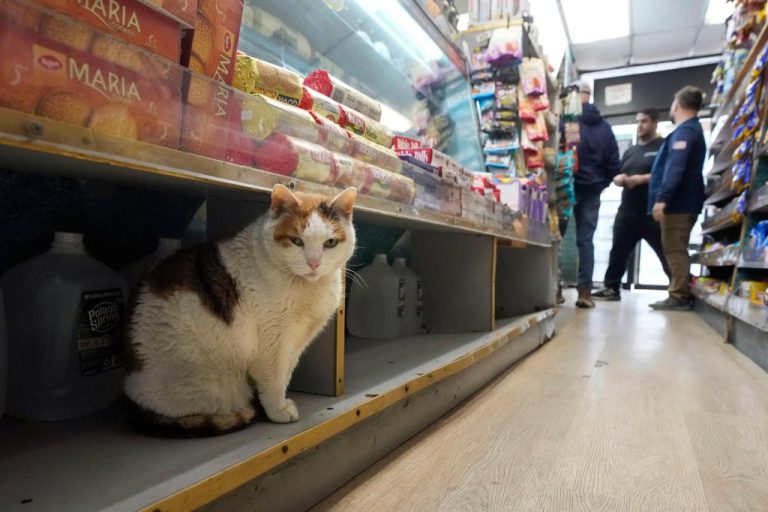
The Toyota Tacoma would have looked out of place even if a leg hadn’t been sticking out of an open door.
The surrounding neighborhood gleamed with two-story homes and curated gardens cut into the hillsides of unincorporated El Cajon. Yet the truck, parked on a dirt lot in a cul-de-sac, featured dented metal and a bed filled with blankets. A tent had been pitched by the back bumper. Bins of provisions lined the ground.
John Oslovar, a captain with the Heartland Fire and Rescue Department, approached the driver’s side. A 911 caller had reported that someone in the truck wasn’t moving, and Oslovar spotted a man lying across the front seat. The captain leaned forward to check for a pulse.
But Oslovar knew there’d be no heartbeat as soon as he spotted the ants.
The man in the truck was among the 495 homeless residents who died last year countywide, a striking toll that nonetheless marked the region’s first drop in deaths among people living outside in more than a decade, according to preliminary data from the medical examiner. The toll has otherwise risen since at least 2012, and three recent years saw deaths soar past 500. More than 600 died in 2023.
All the numbers, however, are almost certainly undercounts, as the agency generally only documents those who die outside or without a doctor. Anyone passing away in hospitals, for example, is harder to track.
The first person lost last year was a 65-year-old Hispanic man, records show. He died of hypothermia in Balboa Park on New Year’s Day. The most recent death came right after Christmas, in Escondido, when a 54-year-old overdosed on methamphetamine.
In between were hundreds more. Seven were killed by trains, an additional 30 struck by vehicles. The historic flooding that hit San Diego last January swept away one couple just before a planned trip to move in with a relative.

Drugs contributed to at least 44 percent of the toll, the largest share by far. “Especially with the fentanyl deaths, it’s a significant problem,” Steven Campman, the chief medical examiner, said in an interview last year. “For our community, of course, but also for our department.”
Yet the overall number is dropping largely due to a decrease in drug-related deaths: The 218 homeless people lost last year to drugs only amounted to about half of 2023’s total. Even if the dozens of cases that remain under investigation all end up involving fentanyl or heroin or something similar, 2024 would still be better than the year prior.
“That’s interesting, because the drugs have gotten even weirder,” Tara Stamos-Buesig, founder and CEO of the Harm Reduction Coalition of San Diego, said in reference to substances like xylazine, an animal tranquilizer that can be secretly laced into other pills.
Stamos-Buesig partially attributed the improving numbers to the widespread distribution of test strips, which can check street drugs for fentanyl, and naloxone, a nasal spray that reverses opioid overdoses.
We must “saturate the community with naloxone, to almost make it so that you’d have to try to avoid it,” said Luke Bergmann, the county’s director of behavioral health services. “I’d like to see bowls of it in the waiting rooms of outpatient clinics.” Just since July, the county and the coalition have helped hand out more than 46,000 doses, which often go by the brand name Narcan, along with 22,600-plus fentanyl test strips. Both are available for free in vending machines around the region.
But naloxone doesn’t work on methamphetamine, the use of which is a growing concern, Bergmann said. Research has shown that meth is sometimes used by homeless residents to stay awake amid the dangers of sleeping outside, including assault from others living in encampments. While Bergmann hopes for more treatment options, he believes much of the problem would be solved by simply getting people housed.
Bergmann and Stamos-Buesig each noted that deaths may also be lower because so many have already overdosed. “A lot of the most vulnerable people are no longer here,” Stamos-Buesig said.
The reduced toll further comes as homelessness countywide appears to be shrinking, at least temporarily. More homeless residents were connected to housing in November than the number of people who lost a place to stay, meaning the crisis contracted for the first time in more than two-and-a-half years, according to the Regional Task Force on Homelessness.
The body in the truck was found on a Thursday in May. As paramedics waited for sheriff’s deputies to arrive, a black sedan pulled up and a man in checkered pajama pants stepped outside.
“Hi, sir,” said Oslovar, the fire captain. “Can we help you?”
The man continued walking. “This is my yard.”
Oslovar gestured toward the truck. “There’s a body right there.”
The man stopped.
“Did you know this guy?”
The man looked through the passenger-side window and exhaled. “Yeah.”
The person in the truck had done landscaping in the area on and off for about a decade, the man said. He’d work for a stretch, save up money and then go surfing. Indeed, a yellow surfboard lay just up the hill.
There weren’t any obvious signs of drinking or drugs, the man added. But the guy had recently mentioned not feeling well. (The medical examiner’s office later blamed the death on methamphetamine use and a heart attack.)
Officers arrived soon after. Oslovar walked over to fill them in. The man in pajama pants remained near the passenger window, his hands behind his back.





